If Star Trek: Voyager is going to commit itself to emulating Star Trek: The Next Generation, there are probably worse ways to do it.
Macrocosm is not a bad riff on Genesis, another sci-fi monster story from Brannon Braga. Braga has an interest in the overlap between horror and retro science-fiction, as demonstrated by scripts from Schisms to Sub Rosa to Threshold. While none of these episodes count among Braga’s best work, and many are considered among his worst, they very clearly represent a subject of interest to him. Given the third season misfires with Warlord and The Q and the Grey, a light run-around action story is not the worst episode that Voyager could produce at this point.
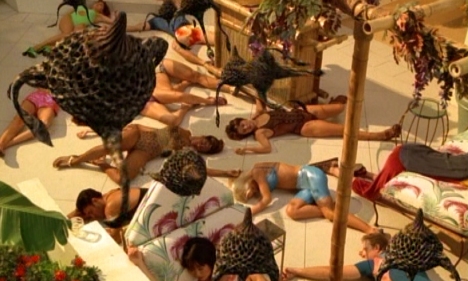
Going viral.
Macrocosm has more than its fair share of problems. It is structured oddly, it is laboured with exposition, it is not technically as tight as it needs to be. However, there is a lot to be said for an episode that casts Kathryn Janeway as John Rambo, stalking killer monsters through the dimly-lit corridors of her own starship. It is at the very least a refreshing change of pace. Besides, if Jean-Luc Picard gets to be an action hero in scripts like Starship Mine or Star Trek: First Contact, it seems only fair that Janeway should get her chance.
The biggest problem with Macrocosm is the episode that it might have been. The original pitch for the episode was much more ambitious than the version that made it to screen. Unfortunately, this is very much the narrative of the third season of Voyager, and perhaps the show as a whole. Macrocosm was a bold idea that was gradually watered down to form a passable imitation of The Next Generation.

“It’s going to get very First Contact in here, very quickly.”
When Brannon Braga first started writing for Star Trek, he was a breath of fresh air. Braga was a young writer with a lot of ambition and a willingness to push the franchise in directions that were new and exciting. Cause and Effect and Frame of Mind are some of the most breathtaking episodes of Star Trek ever produced, representing a clear departure from anything that the franchise had ever done before. Braga’s scripts were generally odd, but they were also relatively unique. Like Ronald D. Moore, Brannon Braga seemed to propose a new model of Star Trek.
After the end of The Next Generation, Ronald D. Moore and Brannon Braga went their separate ways. Moore ended up working on Star Trek: Deep Space Nine under the supervision of Ira Steven Behr, who was determined to push the franchise outside its comfort zone. Working on Deep Space Nine, Moore would develop the skills and mindset that he would later use to run Battlestar Galactica, which is generally regarded as one of the best television shows of the twenty-first century.

It’s not quite gelling.
In contrast, Brannon Braga found himself working on Voyager. The show was markedly less ambitious, with lots of tension in the writers’ room during the first two seasons about whether Voyager should aim to be innovative and experimental or familiar and safe. Ultimately, following some truly spectacular and embarrassing disasters with narrative experimentation, the show settled into a groove where it would be aim to be the most generic version of Star Trek imaginable.
As a writer, Braga largely embraced this approach. Future’s End, Part I and Future’s End, Part II effectively marked a new beginning for the show, one that abandoned a lot of the angst about the journey home in favour of more action-driven storytelling and more familiar Star Trek plotting. Braga would eventually rise through the ranks of the writing staff. He would end up acting as showrunner by the start of the fifth season, and would go on to develop Star Trek: Enterprise with Rick Berman.

Talk about generating buzz.
To be entirely fair to Braga, the writer was still interested in experimentation and innovation. However, for one reason or another, he rarely got the chance to try new things. Braga wanted to expand Future’s End, Part I and Future’s End, Part II into a larger four-episode story, which would have become the franchise’s longest narrative arc at that point. Braga also wanted to extend Year of Hell, Part I and Year of Hell, Part II into another four-episode story and have the ship remain damaged for the rest of the fourth season.
In both cases, Braga was vetoed by the network. UPN did not want a particularly experimental version of Star Trek. They did not want the creative team to take chances that would potentially alienate viewers who had developed expectations of the franchise. Similarly, Paramount was worried about the dangers such developments would pose to syndication. Similar concerns would come into play during the development of Enterprise, when Braga wanted to set an extended opening arc on Earth, but the network wanted something much more conventional.

Silent, but deadly.
Braga’s original pitch for Macrocosm was much more experimental and ambitious than the final episode. As Braga explained to Cinefantastique, he wanted to produce an episode that was largely silent:
The intention actually began, on my part, to do an episode with no dialogue. I wanted to just do a purely cinematic episode with Janeway and a bunch of weird creatures, these macroviruses, viruses as life-sized creatures. Unfortunately it was impossible to do, and I ended up having to put a couple of acts of dialogue in. I just wanted to do something that felt and looked and smelled differently than most shows.
This would have been a striking departure from the norm, something utterly unlike any other episode of Star Trek to date. As such, it is easy to understand the resistance to this idea.
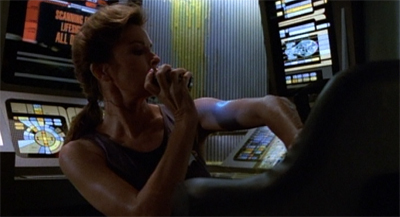
Armed and dangerous.
After all, Star Trek was a surprisingly conservative franchise from a narrative perspective. Ronald D. Moore has talked at length about the difficulties that he had trying to get episodes like Sins of the Father or Family made, episodes that deviated from the narrative expectations of the franchise. Composers like Ron Jones and Dennis McCarthy have talked about being asked to tone down their music to make it “aural wallpaper.” Ira Steven Behr had to fight to introduce long-form storytelling on Deep Space Nine.
However, one of an extended twenty-odd episode season built around (mostly) self-contained narratives is that it affords the production team the freedom to play with bold concepts like that. Modern moves towards shorter seasons and serialised storytelling, both factors that discourage this sort of playful approach to self-contained narrative. Longer episodic seasons encourage playful experimentation and innovation, like the long takes of Triangle on The X-Files or the puppetry of Smile Time on Angel.
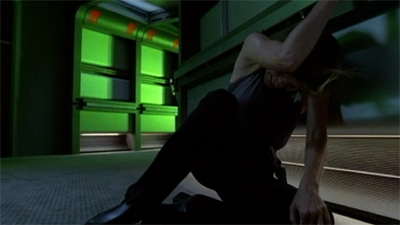
And yet, somehow the holodecks are STILL working.
With twenty-odd episodes a year, it is okay to be a little cheeky and to run the risk of being embarrassed. After all, things go back to business as usual the following week, so what is there to lose? In fact, several nineties television shows broadcast mostly silent episodes. Space: Above and Beyond had produced its own variation almost a year earlier with Who Monitors the Birds? Buffy: The Vampire Slayer would offer a much more high-profile example with Hush three years later.
The decision to shy away from doing a mostly silent episode of Voyager feels like an act of cowardice on the part of the production team. It is another example of the production team backing away from a genuinely provocative idea, much like they did with the tension between the Maquis and Starfleet in the early seasons or much like they did with the idea of a lone Federation ship stranded far from home without support. Macrocosm is a very generic hokey sci-fi episode, but to watch it is to know that it could have been so much more with just a little ambition.

Making light of the situation.
Indeed, the episode’s most effective sequences have nothing to do with dialogue. Alexander Singer’s direction is quite striking and visually distinct, layering a sense of dread and tension as Janeway tries to take back her ship from the weird entities that have laid claim to it. There is that effective and claustrophobic long pan around the turbolift; the sequence of Janeway climbing in the Jefferies Tube, red klaxon light on her face matching her uniform; the camera rushing down the tube towards Neelix from monster’s perspective.
Macrocosm is an episode that might play better with the volume turned down and the music turned up. Its more unsettling scenes have little to do with exposition and dialogue, such as Janeway discovering the slime trail after Neelix is abducted or the camera following Janeway as she moves through an empty Engineering that is still lit by the glowing warp core. Indeed, Janeway even gets a “Rambo suiting up” sequence that is at once absurd and awesome, a great example of how effectively ideas can be communicated through images rather than words.
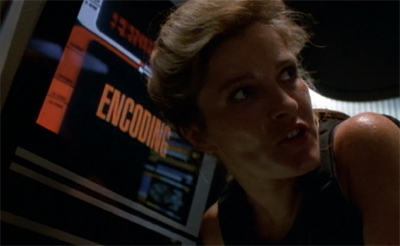
Distress encode.
Indeed, several aspects of Macrocosm are designed emphasise these elements of the script. The floating organisms make a loud buzzing noise as they approach, a way of audibly building tension that does not rely on dialogue or clumsy exposition. Similarly, the closing scene features Janeway listening to some smooth improvisational jazz. In a very smart production choice, the episode closes on an external shot of Voyager set to that jazz music rather than an extradiegetic score.
Unfortunately, for all those different elements that work, there are other sequences that underscore how dialogue undercuts that atmosphere. At one point, Janeway and Neelix discover Ensign Wildman’s quarters. They are empty, only the drone of “A Briefing with Neelix” audible in the background. Food is still on the table. The baby’s toys are still out on the mat. It is a sequence that underscores the idea that something truly horrific has happened, and that it happened suddenly without any warning. However, Macrocosm is unwilling to let the visuals communicate this.
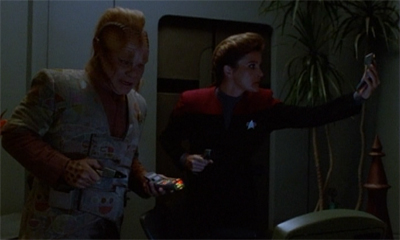
“Somebody watching ‘A Briefing with Neelix’ on loop? Now I know there’s something wrong.”
Instead, Macrocosm offers lots of boring and pointless exposition that serves to kill the mood and eat up the air time. It saps the tension out of the air. More than that, it over-explains everything. The fear of the unknown represents one of the most primal anxieties. Delivering mindless techno-jargon makes the unknown less scary, even if the dialogue doesn’t actually mean anything. After all, the fact that Janeway is delivering that dialogue suggests she understands it, making it less scary to her.
Look at the dialogue in this sequence. “I can’t tell if it’s humanoid, but it’s emanating a bioelectric field,” Janeway states. That is just empty technobabble. The half-glimpsed shadow communicates more. “The programme is set for automatic playback until it’s turned off,” Neelix explains of why “A Briefing with Neelix” is still playing. The show does not need that detail. Scanning the food, Janeway reports, “According to the protein decay, I’d say Ensign Wildman replicated this eleven hours go.” That’s not necessary for the audience to know. The image is enough.
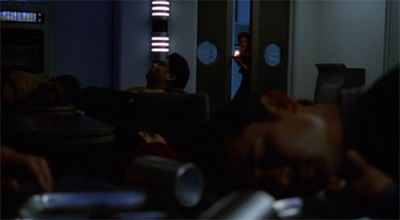
“Oh, boy. Neelix is not going to be happy about this.”
There are other examples over the course of the hour, underscoring how clumsy Voyager is with dialogue in general. When Janeway discovers the crew in the messhall, she insists on repeating their names in a way that feels frankly unnecessary. (“Harry… Chakotay…”) When Janeway and the EMH make their desperate attempt to take back the ship, the EMH is forced to report, “The macroviruses overwhelmed me on deck ten and my portable emitter was nearly destroyed. I’ve taken refuge inside the shuttlebay, in a shuttlecraft.” Some of that dialogue feels redundant.
All of this ties back into the recurring problem that Voyager has with dialogue, a sense that the production team are careless in how they incorporate dialogue into a script and completely unwilling to trust the audience to trust what they are seeing. The truly horrific exposition in Warlord is a great example, but so is the technobabble that has become a fixture of Voyager. The production staff on Voyager repeatedly insist that having characters string together pseudo-scientific words can generate tensions. This is not the case at all. Macrocosm suffers from that.

Packing it in.
Perhaps the worst offence, in terms of plotting and pacing, is the extended flashback in the middle of the episode that explains how these dangerous viruses came to take over the ship. It is something that could be handled within a single piece of dialogue, a log recording that Janeway is listening to as she does something. After all, Star Trek is a franchise about “strange new worlds.” It is not a big leap that the ship might encounter something like this. However, Macrocosm insists upon spending an entire act explaining how these circumstances came about.
This saps the momentum of the narrative. It erodes any sense of tension. It takes the tight focus away from Janeway’s efforts to solve the problem, and instead devotes considerable time and energy to explaining how the problem came around in the first place. It is clumsy and embarrassing plotting, the type of awkward storytelling decision that demonstrates just little the writing staff on Voyager were willing to push themselves. Not only do they abandon the “silent episode” conceit, they abandon the “Janeway takes back her ship” conceit.

“Yeah, I thought we’d have the week off too.”
In some ways, it is almost more frustrating that Macrocosm retains references to that original pitch. The teaser very clearly sets up the theme of communication, introducing the Tak Tak as a species that communicate primarily through gestures. It is an interesting visual, even if the dialogue is still heavy-handed. Even when it comes to aliens who specialise in non-verbal communication, the script is still carefully to bluntly articulate absolutely everything for the audience at home.
The Tak Tak are surprisingly easy to understand for an alien species that are supposedly difficult to parse. “Please make her quiet,” the Tak Tak representative urges when Janeway interjects during the opening conversation. When the Tak Tak attack Voyager at the climax, they explain the situation in language that is very easy to follow. “The Garan Mining Colony infected,” the ambassador states. “We purified them. Your distress call received. Voyager infected. We are purifying you.” It is all very straightforward.
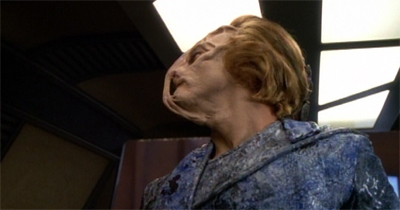
More like the Talk Talk.
Amirite?
Still, the Tak Tak are intriguing, and they serve to set up the idea that words are not the only way in which we interact with one another. “I have studied chromolinguistics, American Sign Language, the gestural idioms of the Leyron, but I just couldn’t get the hang of the Tak Tak,” Janeway reflects. Neelix observes, “It seemed like more than just a language to me, Captain. A lot of their gestures, from what I could tell, were ritualistic. You might even say superstitious.” What we see on screen is fairly generic, but this discussion does recall the lingual barriers of Darmok.
Similarly, the EMH’s first away mission even seems to explicitly acknowledge that heavy-handed exposition is unnecessary and clunky. Keeping an open comm line, the EMH constantly reports to Chakotay. “I am scanning the mine shaft and proceeding on vector one four seven. Ambient temperature is sixteen degrees Celsius. Cavern illumination is minimal but doesn’t pose a problem for my optical sensors. The cave walls are comprised of granite with a mixture of pyroclastic infusions–“

“More like vir-me than virus, eh?”
Chakotay interjects, “Doctor, I appreciate your attention to detail but we don’t need that much information.” It is a nice joke, but one that underscores what would seem to have been the central theme of Brannon Braga’s original pitch for the episode; sometimes words are unnecessary. Unfortunately, the finished episode loses sight of that and the results are less than compelling. Ironically for an episode that was originally intended to minimise exposition, Macrocosm is ultimately overloaded by it.
The result is that Macrocosm feels less like its own thing and more like a recycled plot from the seventh season of The Next Generation. This does little to counter the sense that Voyager is pathologically afraid of its own identity and insists upon emulating its much more successful elder sibling. After all, The Q and the Grey was very much a riff on QPid, so it seems strange to follow that with an episode that so heavily emulates Genesis. It does not feel like the writers have a grip on what they expect the show to be, simply that they’ve given up on trying to find out.

“I forget why I don’t leave the ship more often… oh, wait…”
In A Vision of the Future, author Stephen Edward Poe quotes Brannon Braga’s approach to developing the characters on Voyager by looking at the physicality of their performances:
It is a synergistic process. The actors have a lot to do with it. Once we all started to watch these actors – Kate Mulgrew in particular – perform, you have a voice to put with the character. You have mannerisms, you have… even the way they walk across the room can help you add something in the scene or just have the idea of who the people are.
This is not a bad approach by any measure. After all, one of the advantages of a medium like television is in allowing actors to flesh out roles and to help the writers to find a unique voice.
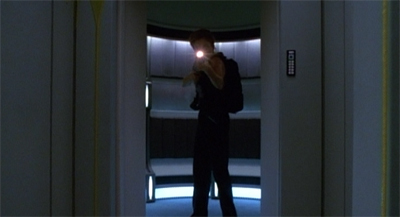
Turbolifting her spirit.
There are plenty of examples from within the Star Trek franchise. On the original show, Leonard Nimoy took stewardship of Spock as a character, frequently writing memos on characterisation and objecting to scripts like Whom Gods Destroy. On The Next Generation, the writing staff initially ignored Worf as a supporting player until Michael Dorn’s performance helped to turn the Klingon into one of the series’ breakout characters. Over the course of the show, the writers tailored characters to the strength of actors like Jonathan Frakes or Marina Sirtis.
On Deep Space Nine, the writers frequently consulted with the actors to help expand and develop the characters in question. When Michael Dorn arrived on that spin-off, he had a number of big ideas about where he wanted the character to go. The decision to move Worf to the Defiant in Bar Association largely stemmed from these discussions. Similarly, the characterisation of Benjamin Sisko was largely shaped in consultation with lead performer Avery Brooks, particularly the emphasis on his relationship with Jake.
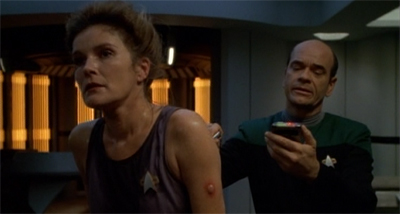
Sicking the virus on her.
As such, there is something disappointing in the way that the production team on Voyager never seemed to tailor their writing in the same way. It is telling that the writers’ observations about the performers served primarily as extended in-jokes. In A Vision of the Future, Stephen Edward Poe explains that Macrocosm is one such example:
Written, coincidentally, by Brannon Braga, the Tak Tak combined a unique form of body language and gestures with their speech patterns. The resulting conversations with Voyager’s crew were interesting to watch. The inspiration for this unusual cultural twist was the fact that Mulgrew has a habit of frequently placing her hands on her hips. In the Tak Tak culture, this gesture is an insult of the grossest kind.
It is disheartening that the most that the Voyager writing staff could do to play to Kate Mulgrew’s strengths as an actor was to create an entire alien culture offended by her habit of placing her hands on her hips. “I may never put my hands on my hips again,” she jokingly laments early in the episode.
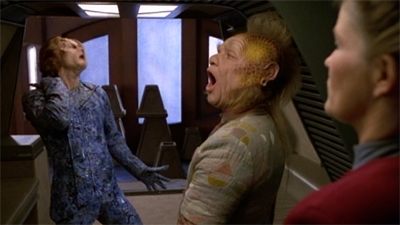
It’s hip to be square.
Macrocosm is also notable for the central antagonists, a race of giant viral organisms that attack individuals in the same way that ordinary viruses attack cells. This is a rather goofy concept on a practical level, as audiences wonder how these things are able to fly. However, it quite an intriguing science-fiction high concept. More than that, it taps into a lot of nineties anxieties about viral contagion. As with the introduction of the Vidiians in Phage, it feels very much like an expression of the fear generated by the AIDs virus, right down to the creepy penetration imagery.
However, the aliens are also interesting from a technical perspective. They are created almost entirely through computer-generated imagery. In the mid-nineties, this was still a developing field. Mainstream blockbusters were still only flirting with the technology at this point, and had not embraced it completely. It was considered something that was very difficult to pull off on a television budget and schedule. As such, the appearance of computer-generated aliens in the third season of Voyager is remarkable.

A hole host of trouble.
In the documentary Red Alert! Amazing Visual Effects, Ronald B. Moore draws a clearly line between the use of computer-generated imagery in Macrocosm and the début of Species 8472 in Scorpion, Part I:
The important thing was, when the show was all done, we got it. It’s like anything else, you get down with it and you see all the things you coulda done better. But Jeri Taylor came up to me one day and said, “It worked. We’ve got it. This is a much better creature than the ones we’ve seen before.” Remember, she was referring back to things like the monster in the cave we were talking about in Basics, that were pretty simplistic, that didn’t have a lot of acting and stuff to do. Which is hard for us. We can make the creatures, but getting them to act… This one was a little easier for us, because they weren’t people; they weren’t talking and that kind of stuff. But they were floating around. And it gave her the confidence to write some scripts that I think… I think it was the basis of 8472, that she saw that we could do that and that maybe if we had something with a little more meat on it – literally! – that we could try to move forwards. I look back at Macrocosm as giving us the chance to do 8472.
As much as Voyager might have been reluctant to push forward from a narrative point of view, it was still something of a technical trendsetter.

“Don’t worry, Harry. I’m sure our next encounter with a CGI alien will go much better for you.”
There is, to be fair, something quite frustrating about all this. Voyager was a very technically ambitious show, just like Star Trek was a very technically ambitious franchise. The production design on the television series was always absolutely top-of-the-line, and the production team were willing to trust their make-up designers and set-designers and special effects artists to push the limits of what could be done on a television budget and schedule. This makes the lack of ambition on the part of the writers all the more unforgivable.
The viral aliens in Macrocosm have not aged particularly well. Even at standard definition, they look heavily pixellated. These menaces looked like they escaped from a videogame at the turn of the millennium, as if Janeway has inadvertently wandered into Doom. In fact, it is easy to imagine that Macrocosm would look ridiculous if CBS ever gets around to digitally remastering Voyager for high definition like they did with The Next Generation. They scream “mid-nineties CGI!”
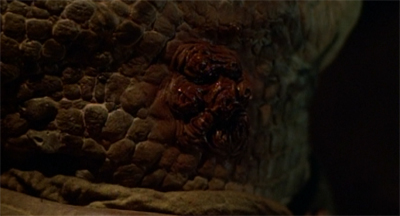
Strange is all too common in this neck of the woods.
In a way, this underscores some of the limitations of computer-generated special effects. More than any other technique, computer-generated imagery teases verisimilitude. Really good computer-generated imagery is indistinguishable from the real deal. However, this treats realism as the desired objective of any special effects, ignoring the fact that special effects can be appreciated on a simple aesthetic level that has little or nothing to do with how “real” they look.
So when computer-generated effects work well, they really work. However, when they do not work well, they are jarring and distracting. It is entirely possible to appreciate unconvincing animation or model work from an aesthetic perspective. After all very few of the practical effects on the original Star Trek are particularly convincing, but the very best ones are still beautiful to look at. Ray Harryhausen’s work was quite arresting, even if it never looked like anything resembling reality.

Tentacles of doom.
In contrast, unconvincing computer-generated special effects rarely have that impact. Because the primary appeal of computer-generated effects is verisimilitude, they are rarely stylised in the way that other special effects are. So when computer-generated special effects do not look convincing, they rarely look good. It is very hard to appreciated computer-generated imagery as a stylistic affection because it works so hard to present itself as something tangible and “real.”
(This is perhaps why Pixar have enjoyed such success with computer-generated animation. The company put an emphasis on the animation rather than the realism, adopting a more stylised approach to computer-generated narratives that never aimed for verisimilitude. Indeed, many Pixar characters are animated in styles that contrast, to the point that integrating characters from one film to the next would not be easy. However, because most computer-generated special effects are supposed to be convincing, they do not adopt that stylised approach.)
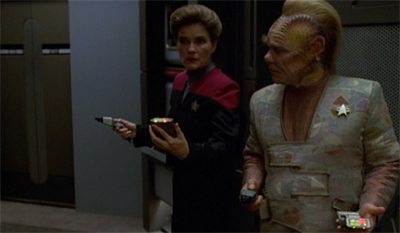
Doesn’t scan.
As a result, the computer-generated alien species in Voyager and Enterprise will simply never look as good as the aliens generated by practical effects on the original Star Trek. The Mugato in A Private Little War and the Melkons in Spectre of the Gun might never have looked “real”, but they were not meant to. They looked like really great designs. In contrast, the gigantic viral agents in Macrocosm or the insect!Xindi in The Xindi will never look that memorable or striking because they are not stylised in the same manner.
Macrocosm is a reasonably solid action episode. Its biggest failing is that it is not anything more ambitious.
You might be interested in our other reviews from the third season of Star Trek: Voyager:
- Basics, Part II
- Flashback
- The Chute
- The Swarm
- False Profits
- Remember
- Sacred Ground
- Future’s End, Part I
- Future’s End, Part II
- Warlord
- The Q and the Grey
- Macrocosm
- Fair Trade
- Alter Ego
- Coda
- Blood Fever
- Unity
- Darkling
- Rise
- Favourite Son
- Before and After
- Real Life
- Distant Origin
- Displaced
- Worst Case Scenario
- Scorpion, Part I
Filed under: Voyager | Tagged: Brannon Braga, macrocosm, special effects, star trek, star trek: voyager, viral, voyager |




















Sadly I’m not sure ‘Voyager’ had the character depth to make a silent episode work. ‘Hush’ worked so well because we knew Buffy, Willow, Giles and Xander inside out – so much so that Whedon could give us big character moments in the episode (most importantly establishing for Willow.)
‘Voyager’ has a fine cast but the thought of spending a silent hour with Chakotay or Harry Kim has limited appeal.
To be fair, the structuring of Macrocosm suggests that the earlier version of the episode would have been built around the two strongest characters in the show, Kate Mulgrew as Janeway and Robert Picardo as the EMH. But yeah, an hour with Chakotay and Kim would have been insufferable.
“Macrocosm is a reasonably solid action episode.” I wish I could enjoy it on that level, but the awful CGI really detracts from even that side of it for me. Also, as you point out, all the momentum is stopped by the long flashback, which is why I prefer Genesis if I am to see this kind of episode. In that episode, we see things beginning to slowly fall apart without really knowing what is going on, which is more unnerving than anything in this episode. I can’t say I love Genesis, the second half is repetitive and the science is ludicrous, but it is much more chilling than this episode.
Also, I think there was a missed opportunity with Janeway having a scientist background, she should have felt some sort of strange sympathy or at least fascination for the creatures akin to Sisko’s sympathy for the growing galaxy in “Playing God” or Picard’s desire to communicate with the Crystaline Entity.
I am fonder of the CGI than most, I think. If only because it’s interesting to see it in the context of the time. We’re really not too far from Playstation graphics here, which is ambitious for the time.
I remember when I was a little kid, liking this episode. Will have to rewatch it. I like the concept.
Another of my unrelated questions, how do you feel on the Animated Series? Ive been watching it for the first time on Netflix, and I really like it, even though its a 70s kids cartoon, it very much feels like another season of TOS
@Cybersyn I’m watching it now! It’s airing on MeTV. Imagine my delight when my first episode involved a planet of women who enslave men. It’s like sitting in a well-worn recliner! 😛
Oh wasnt that the plot of a third season TOS episode?
I’ve said before that Brannon Braga is a highly erratic writer. When he gets it right he gets it very right but when he doesn’t… Macrocosm falls somewhere between the two. The idea of a literal airborne virus is something strikingly original and makes for a new kind of alien invader. The first half has lots of lovely touches that implies all sorts of horrible things have befallen the crew: the active equipment lying in the corridor; the sinister implication that Naomi Wildman has vanished along with the rest of the crew; the buzzing that can’t be pinned down; the POV shot of the macrovirus sneaking up on the unsuspecting Janeway on the Bridge, etc.
But it’s when we get to the midsection that Macrocosm slows right down with a whole act full of exposition about what happened on Voyager while Janeway and Neelix were away. Genesis, for all its flaws and silly science was more structurally sound and allowed us to experience the de-evolution of the Enterprise crew right along with Picard and Data. Macrocosm abandons that approach as soon as Janeway gets to Sickbay and the Doctor goes on at length about the macrovirus that grinds it to a halt.
But it does get itself together for a satisfying finale (even though bringing the Tak Tak back at a late stage is just to add some artificial suspense and make it not so easy to eradicate the macrovirus) and I did like Janeway’s final fight with the virus. Macrocosm is undeniably flawed but it does have moments of greatness and the macrovirus like the Vidiians (they’re a logical extension from them being a walking disease), the Botha and the Swarm are among Voyager’s most interesting alien races.
Yep, i think it was Braga who argued that the Delta Quadrant should be home to the weirdest most high-concept Star Trek aliens imaginable, and I think he has a fair point. And you can certainly see shades of it in the scripts that did make to screen, even if it often felt like the rough edges had been smoothed off, as they are here.
There’s a sense that Braga was in some ways curtailed by the show’s conservatism, that there were certain formal expectations when it came to Star Trek aliens and that Voyager had to adhere to those. I’d love to have seen what Braga might have done if he’d been granted the conceptual freedom that exists on shows like Doctor Who, where he might have had the freedom to do something as weird as the Weeping Angels or the Silence.
“Ensign Wildman’s quarters…are empty, only the drone of “A Briefing with Neelix” audible in the background. ][….] Neelix explains of why “A Briefing with Neelix” is still playing.”
The show I watched had the name of Neelix’s tv show as “Good Morning Voyager.”
It must be that you watched a non-US version of the show. Americans would readily recognize the parody of “Good Morning America,” a bland general-interest morning news and talk show (and on which Neelix would kind of fit in and few of the other characters would). The parody is also that the real US audience for this show would be similar to the demographic of the crewmember whose quarters they are investigating: a mother raising a baby at home, keeping the show on in the background.
I wanted to write in because I noticed this big naming difference. I wonder how many other little changes there are like that between the US and UK[?] versions? To say nothing of actual dubbing translation into other languages.
“A Briefing with Neelix” sounds very strange to me for the kind of program this was supposed to be, but maybe it references a UK morning news show.
It’s not a regional difference. Both names were used, just in different episodes.